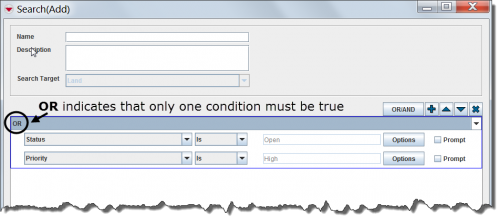Difference between revisions of "And Versus Or"
(Created page with "<table cellspacing="5" cellpadding="0" style="float: right; clear: right; color: black; background: #f9f9f9; border: 1px solid #aaa; width: 22em; margin: 0 0 1.0em 1.0em; padd...") |
|||
| (15 intermediate revisions by 4 users not shown) | |||
| Line 1: | Line 1: | ||
| − | + | Search definitions allow you to specify two different kinds of logical conditions. When you specify search criteria you may need all search criteria to be true in order for a record to be included in the search results. In this situation, the AND condition indicates that each and every search criteria be true for a record to be included. If any of the criteria within the AND node is false, the record will not be included in the search result. For example, the search definition shown in the image below requires that a land have a status equal to ''Open'' and a priority equal to ''High''. In this example, both conditions must be true in order for the land to be included in the result set. | |
| − | |||
| − | |||
| − | |||
| − | |||
| − | |||
| − | |||
| − | |||
| − | |||
| − | |||
| − | |||
| − | |||
| − | |||
| − | |||
| − | |||
| − | |||
| − | |||
| − | |||
| − | |||
| − | |||
| − | |||
| − | |||
| − | |||
| − | |||
| − | |||
| − | |||
| − | |||
| − | |||
| − | |||
| − | |||
| − | |||
| − | |||
| − | |||
| − | |||
| − | |||
| − | |||
| − | |||
| − | |||
| − | + | [[Image:ExampleSearchUsingANDCondition.png|center|500px|''Example of a Search Using the AND Condition'']] | |
| − | |||
| − | [[Image: | ||
<div align="center"> | <div align="center"> | ||
| − | '' | + | ''Example of a Search Using the AND Condition'' |
</div> | </div> | ||
| − | In other situations, an item record may only need to satisfy one search criteria to be included in the search results. When this is the case, you should use the | + | In other situations, an item record may only need to satisfy one search criteria to be included in the search results. When this is the case, you should use the OR search condition. The OR condition indicates that only one search criterion must be true. |
| − | [[Image: | + | [[Image:ExampleSearchUsingORCondition.png|center|500px|''Example of a Search Using the OR Condition'']] |
<div align="center"> | <div align="center"> | ||
| − | '' | + | ''Example of a Search Using the OR Condition'' |
</div> | </div> | ||
| − | The | + | The AND and OR conditions group the search criteria within the group together. The search conditions can be [[Nested Search | '''nested''']] within one another to create more complex search criteria. |
| + | |||
| + | {{NavBox HowTo Search}} | ||
| − | [[Category: | + | [[Category:NAA]] |
| − | |||
| − | |||
Latest revision as of 09:11, 18 March 2019
Search definitions allow you to specify two different kinds of logical conditions. When you specify search criteria you may need all search criteria to be true in order for a record to be included in the search results. In this situation, the AND condition indicates that each and every search criteria be true for a record to be included. If any of the criteria within the AND node is false, the record will not be included in the search result. For example, the search definition shown in the image below requires that a land have a status equal to Open and a priority equal to High. In this example, both conditions must be true in order for the land to be included in the result set.
Example of a Search Using the AND Condition
In other situations, an item record may only need to satisfy one search criteria to be included in the search results. When this is the case, you should use the OR search condition. The OR condition indicates that only one search criterion must be true.
Example of a Search Using the OR Condition
The AND and OR conditions group the search criteria within the group together. The search conditions can be nested within one another to create more complex search criteria.
| ||||||||||||||||

